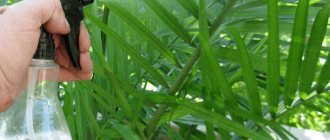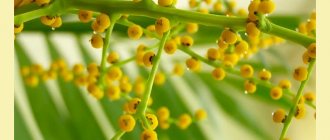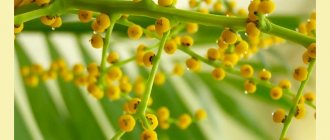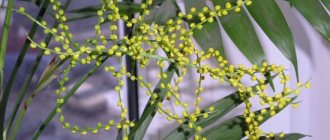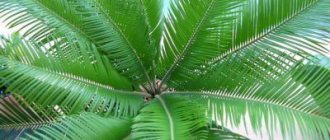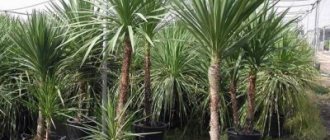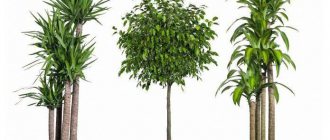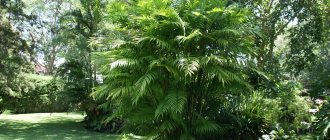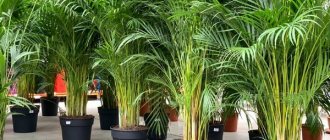Hamedorea is a fairly large genus of palm trees, which includes almost one hundred species. Good places for it include the mountainous region of Mexico, Central America and South America (northern part) to Brazil, Peru and Bolivia. This plant received another name - mountain palm. They usually grow in the undergrowth of mountain forests, less often in lowland rain forests. In the shade of tall trees.
These are graceful miniature palm trees with thin bamboo- or reed-like stems 1-3 cm thick and 1-2 m high (rarely up to 6 meters in nature), very diverse in size, appearance, leaf shape, and the nature of the inflorescences. Many of them have a single stem. Carrying at the top a small, more or less compact bunch of leaves. however, most members of the genus are multi-stemmed plants in which lateral shoots arise as suckers on underground or aboveground stolons or rhizomes. As a result, rather loose groups of stems are formed, sometimes occupying a large area. The leaves are finely textured, mostly pinnate, with many narrow leaves in some species. Others have sparse, but wider leaves, although a significant part of the species have entire leaves with a bilobed tip.
Hamedorea elegans is an attractive variety for home landscaping.
This palm tree needs special care - remove dust from the leaves, sometimes arrange a tropical shower. I do not recommend using a lustrating solution for this plant, as it damages the leaves. We systematically remove dead and dry leaves.
Hamedoreas bloom at a very young age and often bloom in cultivation, not only in greenhouses, but also indoors. Their flowers are collected in simple or weakly branched spike-shaped inflorescences, greenish, yellowish or cream, formed in the axils of the leaves or below the leaves. Moreover, male inflorescences are often more branched than female ones. The flowers are sessile or even partially immersed in the soft tissue of the peduncles. As the fruits ripen, the axis and branches of the inflorescence change color to brighter - yellow, orange, coral-red. And they form a sharp contrast with the shiny black fruits the size of a pea.
Hamedoreas are dioecious plants: male and female inflorescences are formed on different specimens. Sometimes slightly different in appearance. This often causes confusion in classification, when different-sex individuals of the same species are described under different names. The confusion is aggravated by the easy ability of chamedoreas to interbreed and, in general, some variability of species.
So Hamedorea is a genus that has not yet been sufficiently studied, and identifying many of its species is a rather difficult task.
The small size of the plants, their extraordinary grace, easy ability to flower under cultivated conditions and bright color during the fruiting period, combined with their unpretentiousness, have made them one of the most favorite palm trees in indoor and greenhouse cultivation.
The most famous among them is Hamedorea gracica or Neanta gracica , native to Mexico and Guatemala. This is a low, slender, 1-2 meters tall, multi-stemmed (in cultivation mostly single-stemmed) palm tree with thin (2.5-3 cm) bamboo-like segmented stems with closely spaced nodes. The small crown consists of 6-7 dark green, pinnate leaves 60-100 cm long, with 8-15 pairs of lanceolate or sigmoid leaflets with a long-pointed tip. Spike-shaped inflorescences, collected in loose panicles, change color from pale green or cream to coral red as the flowers and then the fruits develop. Often on the same plant you can simultaneously see several panicles in different stages of development: some with flowers, others with black shiny fruits.
In addition to Hamedorea gracefu, several other species are found in indoor culture.
Hamedorea petulosum is a shrub-like palm from Mexico with thin reed-like stems. Unlike the previous species, it easily branches in cultivation. The stems have long internodes, covered with dry sheaths of dead leaves. The pinnate leaves are arranged more or less evenly in the upper half of the stems. Thin leaves, numbering 7-9 pairs, broadly lanceolate or oblong with a long-pointed tip, dark green above, bluish below. The terminal pair of leaflets grows together into one deeply bifid leaflet in the shape of a fish's caudal fin. The plant is especially decorative when numerous shiny orange to red fruits ripen in branched clusters.
Hamedorea unicolor is a very beautiful shrubby palm tree native to Mexico and Guatemala. Its thin, reed-like stems, 2-3 m high, form a more or less dense group. In this case, the tillering node is usually slightly raised above the ground surface. Each stem bears up to 8 graceful feathery leaves. Thin light green leaves are narrower and longer than those of the above-mentioned species, more numerous. The terminal pair of leaflets is united into one bilobed one. The fruits are golden-yellow in multi-branched clusters.
Hamedorea Ernest-August is a low, up to 1.2 meters tall, palm tree with a single thin stem with strongly swollen close nodes from which roots extend. It differs from the three previous species in its solid, broadly wedge-shaped leaves with a deeply bilobed apex. Female flowers are in simple, unbranched, bright red spike-shaped inflorescences. Male ones - in multi-branched racemes. The fruits are shiny black. It grows in moist forests on mountain slopes in Mexico and Guatemala.
The following forms are also known: Hamedorea tall with a more compact crown and dark green leaves is much less popular than Hamedorea graceful. The leaves of Hamedorea Costa Rican have the shape of a beautiful fan. Among the dwarf species, Hamedorea cataractum with a trunk with white spots and dark green leaves is common.
Description
Hamedorea is native to Central America. It is less common in northern South America, Madagascar. The second name of the plant is bamboo palm; the variant mountain palm, neanta, is also sometimes used.
Most species of chamedorea are low-growing or dwarf trees. But representatives of this genus also include vines and shrubs. At home, it is the latter option that is often grown.
The Hamedorea palm has a creeping rhizome from which numerous shoots arise. Over time, they produce new stems, forming dense thickets.
The stems of Hamedorea are bamboo-like, with short internodes, no more than 3 cm in diameter.
At the top of each stem a bunch of leaves is formed, consisting of 5-7 pieces. As the trunk grows, the lower leaves fall off, leaving a light mark on it.
The plates are painted bright green. In most species they are dissected and reach 40 cm in length.
The bamboo palm is a slow growing species. Over the course of a year, it can form 1-2 leaves. But this is a long-lived flower.
With proper care, chamedorea lives up to 40 years.
Therefore, even at home it can reach 1.5 m. Although indoor specimens more readily grow not in height, but in width, producing new stems.
Hamedorea does not contain toxic substances. Cats like this palm tree; they readily gnaw on it. Therefore, pet owners should consider potty placement.
The bamboo palm produces 2 types of flowers - male and female. But on a single specimen only one type of bud appears.
Male flowers are spherical in shape and reddish in color. They are collected in inflorescences located on long peduncles.
Female palm flowers are yellow and orange. They grow singly on stalks.
Hamedorea is not considered a beautifully flowering plant. It is grown for its decorative foliage.
Scientists believe that the bamboo palm exhibits high phytoncidal activity and purifies the air.
Types and features of indoor palm trees
Today, purchasing a large and spectacular palm tree may remain a pipe dream for many people, since the cost of such a specimen is quite high. A palm tree grown in a specialized nursery can certainly become the main decoration of any home. But you should remember that if you purchase an already mature plant, you are taking a big risk. The point is that if it finds itself in unusual conditions, it can get sick and even die. Experienced gardeners advise buying small shoots or young plants. They adapt much more easily to new growing conditions and changes in care. And they will increase the green mass over time.
The most spectacular part of this genus of plant is considered to be its leaf plates, which have an extremely unusual shape and spectacular appearance. The shape of the leaves directly depends on the species. So, the leaves can be narrow, straight, have the shape of a semicircle, etc. But it should be remembered that the leaves of palm trees should never be cut off. The fact is that removing even one leaf blade can lead to the death of the entire plant.
But which of the many types of palm trees will be suitable for your apartment? You can understand this by reading the description of the most popular species among gardeners.
Features of bamboo palm
A species called the bamboo palm is very popular among palm gardeners. The name of such a plant is quite unusual, as is its appearance, which is also incredibly impressive. Externally, the leaves have a certain resemblance to bamboo, which is why this plant got its unusual name. This plant is loved by a large number of gardeners due to the fact that it is fast-growing and easy to care for. The main thing is to provide such a palm tree with fairly abundant watering. The following plants belong to the bamboo palm.
Neanta
This plant is most popular among gardeners. As a rule, it is purchased in a specialized store as a very small seedling. After this palm tree is brought into the house, it is recommended to transplant it into a new pot slightly larger than the previous one. After this, the neanta needs to provide the most favorable conditions for its growth and development. After just a few years, your room will be decorated with an already mature, luxurious plant. If such a palm tree has enough light and is provided with proper, sufficiently abundant watering, then it can bloom and bear fruit. So, small yellowish flowers appear in its upper part, and then berries are formed.
Date palmate
This plant, which has a spectacular appearance and grows in wild conditions, is quite successfully grown in city apartments. The domestic plant looks exactly like its wild counterpart, only it is smaller in size. When grown at home, the palmate date can reach a height of about 200 centimeters. However, its growth can be controlled, and this will not cause you much difficulty. So, you just need to cut off the top of the plant in a timely manner.
Coconut
Such a palm tree, as a rule, grows only in wild conditions. At home, or rather, in a stuffy room, it grows for about 2 years, and then quickly and suddenly dies for no apparent reason.
Weddel Coconut
This palm tree is quite suitable for growing at home. But in order for it to have a very impressive appearance, as well as to grow and develop normally, it is necessary to provide the most suitable conditions for it.
So, for this palm tree it is very important to provide comfortable humidity, appropriate temperature conditions, as well as good lighting
Fish tail
This plant has gained popularity among gardeners due to its rich color and unusual shape of the leaf plates. However, what is attractive about this palm tree is not only its very impressive appearance, but also its fairly simple care. Thus, a specimen purchased at a flower shop can grow and develop normally in indoor conditions.
However, just buying a palm tree and bringing it home is not enough. You need to learn how to properly care for her, then she will delight you every day with her exotic and incredibly beautiful appearance.
features of palm tree care. CHARACTERISTICS OF ROOM PALM PALMS.
Watch this video on YouTube
Popular types of Hamedorea
Types of Hamedorea differ quite greatly in appearance, but require similar maintenance conditions.
Elegance or Graceful
The most popular type of bamboo palm. The plant owes its popularity to its unpretentiousness and original appearance.
Hamedorea gracefula easily forms buds and can bloom all year round. Its inflorescences resemble mimosa.
The leaves consist of 24-28 lanceolate fragments. The height of adult specimens, even at home, exceeds 1.5 m.
Other types
The leaf blades of Ernest-August chamedorea are whole, only at the top they are divided into 2 parts. The maximum height of the plant does not exceed 1.2 m.
Chamedorea metallica has wide and leathery leaves. Like the Ernest-Augusta variety, they are solid, forked at the top.
A distinctive feature of this palm tree is the silvery hue of the leaf blades. This type of chamedorea does not form additional trunks.
The monochromatic chamedorea has feathery leaves and looks very much like an elegant one. But this species is more suitable for greenhouses; it is rarely found in houses.
Hamedorea erupta is a low, willingly bushy palm tree.
Hamedorea stolonifera is easily recognized by its many aerial roots and whole leaves.
Cascade, also called cat palm, is one of the fastest growing species. It is distinguished by many shoots and dark green feathery leaves.
How to propagate
- Reproduction of chamedorea is carried out by seeds, air layering, and multi-stemmed species - also by separating offspring. Seeds are sown at a temperature of 24-26 degrees. Seeds germinate slowly, in the optimal case, a month after sowing, but sometimes you have to wait from several months to six months for entry. The suckers will be separated in late winter or spring, before new growth begins. This must be done carefully, trying not to damage the roots.
Air layering is used if it is necessary to rejuvenate an old, overgrown specimen with a very bare stem. This applies primarily to single-stemmed palms, in particular to Hamedorea Ernest-Augustus. When its only trunk becomes bare and loses its decorative appearance, the leafy top of the trunk is cut off under one of the nodes with adventitious roots extending from it, without even resorting to first covering it with moss, and planted in a separate pot. In order to quickly get a beautiful potted specimen of Chamedorea gracilis, several seedlings are planted in one pot.
Chrysalidocarpus and chamedorea, the differences between them are not large, so these two different plants are very often confused. Sometimes on sale Chamedorea elegans is confused by inexperienced gardeners with chrysalidocarpus or howea.
Hamedorrhea: care at home
Hamedorea is not picky about lighting, but requires spraying and a properly adjusted watering regime.
Lighting and location in the home
The Hamedorea palm is a shade-tolerant plant. Exposure to direct sunlight causes sunburn: brown spots appear on the leaves.
In nature, the palm tree has adapted to life in partial shade or in diffused light. At home, it is even placed near north-facing windows or in the back of the room.
A tub of chamedorea can be kept in the corridor and other places where there is no natural light. It grows well thanks to artificial light sources.
It is enough to illuminate this shade-tolerant palm for 10-12 hours. And the illumination level may not exceed 1000 lux.
Description of the plant
Chamaedorea are evergreen, compact, slow-growing, multi-stemmed, feathery palms that form thickets or colonies. Species with a single stem are rare. In indoor format, they are limited to a maximum of 2 meters in height, most varieties are up to 1 m, they grow mainly in width. Graceful trunks with “joints” are covered with interesting traces of fallen leaves, reminiscent of reed or bamboo stems. Each of the thin shoots bears up to 7 luxurious feathery leaves up to 30 cm long on very long cuttings.
Tough, brightly colored, matte, feathery, occasionally whole or forked leaves make chamedorea airy and light. The leaf lobes are thin, pointed-lanceolate, usually very narrow. At the ends, the leaves curve elegantly in arches.
During cool wintering, chamedorea blooms even in ordinary rooms. And you don’t have to wait decades for flowering. The luxurious fragrant panicles of male plants consist of rounded unusual flowers, reminiscent of mimosa and look very elegant, which cannot be said about the single flowers of females. With successful cross-pollination, black peas of berry-shaped fruits are formed, which looks very decorative on the bright reddish petiole.
Hamedorea is one of the most valuable filter plants that absorb harmful impurities from the air (formaldehyde, benzene, trichlorethylene, etc.).
Transfer
Hamedorea is replanted in the spring. Young specimens need to increase the pot every year.
Mature palm trees only need to update the soil. They change the top layer of soil. You can replant once every 5 years or less often if the roots do not start to poke out of the drainage holes.
A newly purchased palm tree is replanted almost immediately (maximum 12-15 days). The season does not matter.
Priming
Hamedorea is planted in special soil for palm trees. Soil mixtures sold in flower shops are peat-based and already contain perlite and sand. They can be enriched with charcoal to prevent infections.
The soil for chamedorea should be neutral, pH 6-6.5.
When preparing it yourself, peat, humus and turf are used as components in equal proportions. This mixture is loosened with sand in an amount of ⅙-⅕ of its volume.
Drainage is laid out at the bottom of the pot. It should occupy ¼ of the height of the container.
Pot
During a planned transplant, the diameter of the chamedorea pot is increased by only 2-3 cm. You should not take the container “for growth.” This will lead to acidification of the soil.
For a bamboo palm, the material used to make the pot is not important. But for tall adult specimens, ceramic or wooden tubs are often preferred, because they are more stable.
However, you should not take a container that is too deep. The diameter must be greater than the height. The rhizome of Hamedorea grows in breadth.
Recommendations for transplantation
A healthy chamedorea needs to be replanted by transshipment. Before removing the plant, tap the pot on all sides to make it easier to remove the palm tree.
Sequence of actions during transplantation:
- Hamedorea is removed from an old pot.
- The earthen ball is inspected. If there is no suspicion of root rot, it is not destroyed.
- The plant is placed in the center of the new pot.
- Fill the voids with earth.
- Water the soil and place the palm tree in the shade.
If Hamedorea is replanted because the old soil has turned sour or the roots have begun to rot, the soil must be cleaned as much as possible. To do this, use a wooden stick or wash the roots under water.
Damaged areas are cut off, healthy areas are treated with fungicides.
You can see how chamedorea is transplanted after purchase in the video below.
Growing and care
Location, lighting and temperature
Prefers shade . For full growth and development, diffused and soft light is needed. Aggressive rays can cause a burn, causing the green mass to change color to yellow and begin to fall off. The right decision when choosing a location is the western and eastern windows. For beneficial development it is necessary to create conditions that are as similar as possible to natural ones. But this can only be achieved artificially. To maintain the symmetry of the crown, the container with the palm tree is rotated around its axis every 3 months.
The indoor pet loves warmth. In summer, the optimal thermometer readings are from +19 to +24. In winter, the thermometer should not fall below +16. Otherwise, there is a threat of the development of many dangerous diseases, and sometimes the death of the exotic. If it is higher than the stated standards, you cannot do without frequent and proper irrigation. Regular ventilation of the room, without drafts, will also not be superfluous.
In the middle of the year, you can take a vacation and take it out onto a glassed-in balcony with shade.
Humidity and watering
In this regard, the plant requires increased attention. To create the right conditions (at least 50%), it is recommended to spray it in the morning and evening (from June to September). It is better to use moisture from melted water or rain, not cold. If this is not possible, then an electric air humidifier or a tray with expanded clay, which is periodically filled with water, will be an excellent assistant. In winter, irrigation is stopped so as not to cause illness.
Despite the love for moisture, “drinking” must be done correctly. Under no circumstances should liquid stagnate . This threatens with serious consequences. Such as rotting of the root system. In the hot season, moisture is often poured, but only after the top layer of soil has dried. From autumn to spring, the palm tree's need for it decreases significantly. It is enough to water it once a week. Temperature and quality of life-giving moisture play an important role. It should be warm and clean, without harmful chemical elements. That is why the contents of the water supply are strictly prohibited from being used.
The frequency of watering is determined by many factors: time of year, temperature and humidity in the room, age and health of the bamboo palm.
Choosing the right pot
Its correct dimensions are the key to rapid growth . It is wise to plant long but narrow roots in a long and narrow vessel. Buy a stable one and the palm tree will never topple over, no matter how big it gets. The height of your pet will help you correctly calculate the dimensions.
For a green beauty 30 cm high, you need a container 15 cm deep.
Soil and fertilizers
The main criterion is its reaction, not texture. Only neutral or slightly acidic is suitable . The easiest way is to use ready-made mixtures, which are called “palm soil” in the store. When preparing it yourself, compost and turf soil are used as a basis. Sand, peat, expanded clay are added to it . Before use, be sure to sterilize by calcination.
During the growing season (from March to October) it needs them every 2 weeks. Owners alternate mineral and organic complexes . You can buy them ready-made at any flower shop - feeding for dracaenas. First of all, flowering depends on them. That is why it is very important to properly breed and provide additional nutrition. Strictly follow the manufacturer's instructions on the packaging. Feeding is suspended with the onset of the dormant period.
Short daylight hours are not the best conditions for stimulating growth, which occurs due to additional nutrition. The shoots during this period are weakened and are not able to form a beautiful crown. No fertilizer is required for newly acquired pets either. They are not added during the first 6 months after transplantation.
Plant pruning
Inspections are carried out regularly to identify yellowed and dying leaves. Ideally, it should not be allowed to die out. They are removed with special scissors (with rounded ends). The same fate befalls panicle inflorescences. At home, they are not able to fully develop, and there is no decorative effect at this stage. This needs to be done as early as possible: they take away useful substances from the bush.
Reproduction
Palm trees reproduce primarily by seeds. But the vegetative method is also suitable for chamedorea.
Seeds
Only fresh seeds collected no more than a year ago are suitable for germination. If they are obtained at home through artificial pollination, they should be planted immediately after collection.
Step-by-step instructions for growing Hamedorea from seeds:
- The fleshy membrane (apex) is removed.
- The seed is soaked for 5 days in clean water.
- Scarification is carried out (the hard shell of the seeds is scratched with a file or sandpaper).
- Place the seeds on a damp mixture of peat and sand, do not bury them or sprinkle them on top. The part of the seed where the shell was damaged should be in contact with the ground.
- The pot with the seed is covered with film.
- The greenhouse is ventilated every day and the soil is not allowed to dry out.
Hamedorea seeds are germinated at a temperature of 25°C. Each seed is planted separately. It is convenient to use 200 ml cups.
Depending on the quality of the seeds and conditions, seedlings appear in 2-8 months.
Growing conditions for indoor chamedorea
The bamboo palm is famous for its very good adaptability. It is quite flexible and, if tamed slowly, can be a joy even in atypical conditions. Hamedorea will easily fit into even the smallest room without creating a bulky effect.
Lighting and placement
Hamedorea is the best palm to place inside rooms. Of course, it will not withstand dense shadow in the corner, and it shows its most interesting colors in diffused bright light, but this palm tree remains decorative even in partial shade of varying intensity. Hamedorea should be protected from direct sun.
It is advisable to adjust the lighting for the winter, but it is imperative to regularly rotate the palm tree for the uniform growth of new leaves.
Hamedorea diseases
The most common disease of bamboo palm is root rot. It is caused by overwatering of the plant, stagnation of water in the pan, especially when kept at a low temperature.
A sign of the disease is the wilting of the plant. Its stems and leaves droop, yellow spots appear on them, and over time the plates begin to turn black.
To save the palm tree, it is replanted with a complete replacement of the soil. In this case, damaged roots are cut off, unaffected roots are treated with fungicides (Fundazol, Fitosporin, etc.) for prevention.
After replanting, reduce the frequency of watering and add fungicides to the water for the first time.
Features of caring for rapis
Lady Palms or Rapis requires care, but we are talking about standard, simple procedures - watering, fertilizing, timely transplants. It is also recommended to regularly inspect the palm tree for diseases and pests.
Irrigation mode
This aspect requires special attention, since most often palm trees become ill due to improper watering. The fact is that these plants suffer both when there is an excess of moisture in the soil and when there is a lack of it. However, the soil should always remain moist.
In summer, rapis is watered quite often and abundantly, especially since at high temperatures the substrate dries out faster. In winter, especially if the palm tree is resting in the cold, the frequency of watering is reduced. The water used is settled and warmed to room temperature.
Trimming
Rapis retain their decorative properties even without this procedure, but palm trees require periodic hygienic dressings. Old, fading, yellowing foliage must be removed; it should be cut at ground level.
At the end of the event, the palm tree is not sprayed or watered: water should not be allowed to penetrate inside the trunk, otherwise it may begin to rot.
How, when and what to feed rapis?
To fertilize palm trees, it is best to select complex mineral mixtures. The following products are considered the most popular:
- Activin.
- Bon Forte.
- NPR standard for palm trees.
- Growth and others.
There are several rules that should be followed to ensure that adding additional nutrition will only benefit your green pet:
- Palm trees are fertilized during the active growing season of the plant - from late spring to mid-October.
- 1-2 procedures per month are enough.
- Before fertilizing, the soil should be shed generously so that the concentrated mineral salts do not burn the tender roots of the rapeseed.
In winter, after transplantation, during illness or infection of a specimen with pests, it should not be fertilized.
How to replant correctly
It is not recommended to disturb mature trees without special need, like other palm trees; rapis experience stress from such events and require a lot of time to adapt.
For large, overgrown specimens, annual replacement of the top layer of soil is sufficient. But a growing palm tree is still replanted when its rhizome becomes cramped in the old pot. A gentle transplantation method is used, which involves moving the plant to a new tank along with the old earthen ball.
It is important to select a container of a suitable shape and size - it should be wide so that the surface root system has enough space and shallow so that the soil in such a pot will not sour. Before transplanting, good drainage must be poured onto the bottom of the pot; this can be vermiculite, clay or ceramic shards, fine gravel or pieces of polystyrene foam.
Before transplanting, good drainage must be poured into the bottom of the pot; this can be vermiculite, clay or ceramic shards, fine gravel or pieces of foam.
Pests
Of the pests, chamedorea is most often attacked by spider mites. As a result of its appearance, the leaves dry out, a white coating forms on their underside, and light yellow spots appear on the top.
This pest becomes active at low air humidity. Therefore, regular spraying is also a prevention of infection.
This is what pests of indoor plants look like: spider mites, mealybugs and scale insects
Less commonly, chamedorea is attacked by scale insects (dark spots appear on the leaves) and mealybugs (a coating resembling flour is visible).
When insects appear, they are removed mechanically - washed off with a shower, collected by hand, etc. After this, 3-4 treatments are carried out with insecticides (Fitoverm, Akarin, etc.).
Diseases, pests and problems in growing
Spider mites, thrips and scale insects are often found on chamedoreas, because the palm tree loses its resistance in the heat, very dry air, and problems with watering. Correction of care and conditions in this case is as important as treatment with insecticides.
Varietal chamedoreas can be affected by fungal diseases and are sensitive to fusarium and blight. Without treating with fungicides, it will not be possible to cope with the problems.
Hamedoreas signal everything with their leaves. Yellowing is a sign that the plant is too cold or hot, the consequences of overwatering or complete drying of the soil.
Hamedorea reproduces well vegetatively. © lukestehr
Other growing problems
If chamedorea has lost its decorative appearance, this is not always a sign of disease or pest attack. The most common problems and their causes are listed in the table below.
| Problem | Probable Cause |
| The tips of the leaves dry out, but the plates do not turn yellow | Insufficient air humidity |
| The leaves are curling | Low temperature Draft |
| Leaves turn yellow | Watering with hard water Excess sunlight |
| Palm tree growth has stopped | Nutrient deficiencies |
| The tips of the leaves have turned brown | Overflow |
| The leaves are darkening | Temperature too high or low |
| Light spots on leaves (no plaque) | Lack of iron in the soil |
| Brown spots on leaves | Burn from the sun or contact with heating radiators |
| Gray coating that can be easily washed off the leaves | Water is too hard |
If the lower leaves gradually dry out, this is a normal process of crown renewal. It is thanks to him that the palm tree acquires its characteristic appearance.
Opinion of an expert from the channel “Flowers in the House. Indoor Plants” you can learn about the problems of growing chamedorea from the video below.
A sign of a problem is that several plates dry out at once.
This may equally likely indicate that the chamedorea is not being properly cared for at home, or that the palm tree has been attacked by pests or is infected.
Where to put
— Lighting . The Hamedorea palm prefers a light shaded location. Protect from bright sunlight. On southern and southwestern windows they need reliable shading. They also feel good on a north window.
— The temperature for them in winter is 16-18 degrees, at night 12-15 degrees, but not lower than 12. In summer, the air temperature should be about 18-20 degrees, since this palm prefers coolness.
- Humidity . Plants in a warm room are sprayed daily with lukewarm water, trying to keep the air near the plants sufficiently humid. To avoid attacks by insect pests, to which chamedoreas are very susceptible, it is very important to keep the plants clean, washing the leaves at least once a month, and ventilate the room on hot days.
The Hamedorea palm, which is properly cared for, will delight you with its flowers. In other words: caring for chamedorea promotes flowering and fruiting. You can see how chamedorea blooms if you notice small panicles. Unfortunately, the flowers are inconspicuous.
Signs and superstitions associated with the bamboo palm
Esotericists believe that only kind, honest people can have chamedorea. It will not benefit anyone who harms others.
Popular beliefs associated with the bamboo palm:
- chamedorea feeds its owner with energy and improves sleep, and also helps to achieve success in business, sports, and creativity;
- darkened leaves indicate the presence of evil spirits and damage in the house;
- the appearance of this plant in the house helps to extinguish conflicts and quarrels in the family;
- chamedorea fights off energy vampires.
Reproduction methods
You can propagate bamboo palm using the following methods:
- Seeds.
- Dividing the bush.
- Root shoots.
Unlike other similar plants, chamedorea has abundant flowering and a large number of fruits. Each of the presented methods of reproduction has its own advantages, so you can always choose the best option for yourself.
Read about the propagation of Hamedorea graceful and caring for the plant here.
Useful properties of chamedorea
An indoor flower brings the following benefits to the gardener:
- release of phytoncides, which are natural antiseptics that destroy pathogenic microorganisms (bacteria, viruses, fungi);
- purifying the air in the room from pollutants and carbon dioxide;
- production of pure oxygen;
- elimination of formaldehyde, benzene, ammonia and other harmful fumes.
Since a large number of leaf plates are found on an adult chamedorea, air purification occurs more actively.
Why do Hamedorea leaves dry and what to do?
Hamedorea is a picky palm. But for high-quality growth of shoots and leaf blades, it is necessary to establish care conditions. If the leaves on a bush dry out and fall off, there are the following reasons:
- too infrequent watering during the growing season or lack of it in winter;
- location directly under direct sunlight, causing burns;
- insufficient amounts of fertilizers or their complete absence, which leads to depletion and deficiency of microelements;
- no replanting, which causes soil depletion, since the plant completely absorbs nutrients.
In this case, to eliminate dryness, you need to establish care. Watering, transplanting, lighting are carried out according to the prescribed conditions. Then the dryness will go away on its own. But excessively affected leaves are removed.
Dryness can develop when a bacterial or fungal infection multiplies. Not all microorganisms and insects are visible visually. If there is a suspicion of infection, the bush is first washed with a soapy solution, then an insecticide is applied.
Hamedorea is an elegant palm tree that looks beautiful in the interior. She is unpretentious and requires minimal care. The plant grows in height slowly, so it does not restrict the room. If you water and replant on time, there should be no problems with your home flower.
Consequences of improper care
Domestic palm trees, despite the ease of care, sometimes get sick. This is reflected in their decorativeness. Problems can also arise due to incorrect content. Timely measures will restore health and attractiveness to the tropical beauty. The table will help you understand care errors and choose a treatment method.
Table - Errors in caring for chamedorrhea
| Problem | Care errors | How to help |
| Leaves turn black and dry | — Insufficient watering; - chamedorea is watered with hard water; —water contains toxic elements: chlorine, fluorine | — Trim “problem” areas; - increase watering of chamedorea using settled, filtered water (preferably rain) |
| Yellow stripes and spots on chamedorea leaves | — The palm tree lacks potassium or magnesium | — Feed the plant by spraying the leaves of chamedorea with a solution of microelements; — feed the palm tree with compost (a layer of two to three centimeters); - add magnesium sulfate crystals to water for watering chamedorea |
| New Hamedorea leaves are very small | — Lack of light; - lack of fertilizers | — Increase the illumination; - feed the palm tree more often |
| Yellowish foliage | - Excess sun; - iron deficiency | — Move the chamedorea to a shaded place; — foliar fertilize the palm tree with iron-containing soluble fertilizers |
Diseases and pests
There are the following types of pests that most often settle on chamedorea to eat the leaves or drink the juice:
- mealybug;
- scale insect, aphid;
- spider mite
Insecticides are used to kill insects. They can be applied for treatment or prevention if an infected flower appears nearby. Aktara, Fitoverm and other drugs are suitable. They are used in accordance with the dosage.
If white areas or active rotting appear on the chamedorea, the problem may be due to fungal growth. It develops in bushes with weak immunity. A fungicidal drug is used. It is also recommended to trim off all parts that have been infected.
In addition to pests, Hamedorea can develop various diseases due to improper care.
- Dry leaves. The problem is insufficient watering, lack of air humidification, and location next to the battery. Humidification conditions need to be adjusted.
- Yellowness. Yellow areas appear when using low-quality water. It is recommended to replace hard water with soft water. For example, you can use filtering.
- Decaying, drooping plant. The cause is excessive watering during wintering. It is necessary to reduce the amount of watering of chamedorea and make the soil looser. You can put charcoal or sphagnum in the soil, which will absorb excess liquid. If the rot has spread to the root, replant, cutting off excess areas.
- Brown spots. Affected leaves need to be cut off and the amount of watering reduced. If the cause is sunburn, move the pot away from the window and shade it slightly.
- Falling of the lower layers of leaves. This means that the main nutrients go to the upper parts of the palm, while the lower layers do not get enough sunlight. This is the norm. To reduce this phenomenon, you need to trim the top branches.
To prevent damage, quality care is provided in a timely manner. All conditions must be met, otherwise most of the affected chamedorea will have to be cut off.
Hamedorea transplant
Palm trees should be replanted towards the end of spring. A sign is that the container is completely filled with roots. Since chamedorea feels quite comfortable in a small container, it is better not to disturb mature trees with this procedure. Replant large trees as necessary (the tub has rotted, pests have appeared in the soil).
Only young (not older than 3 years) plants can be replanted annually.
Tall containers are preferable for transplantation, since the roots of palm trees grow deep down. Do not use a very large pot, because... the root system may not consume all the moisture and, being constantly damp, begins to rot.
Transplant methods
There are two ways to transplant a flower - complete transplantation and transshipment.
When completely replanted, the palm tree is removed from the container, the root system is cleared of the previous lump, and rotten roots are removed. If necessary, the shoots are separated. Freshly prepared soil or Palma soil is poured into the pot on top of the drainage.
Young plants are replanted on average once a year.
- Plants older than 3-4 years - on average once every two years. In general, the older the plant, the more time it can spend without changing the soil.
- However, botanists recommend replanting even old plants at least every 3 years, at least from a sanitation point of view.
However, the plant will more easily tolerate such a method of transplantation as transshipment, in which the tree, along with a clod of soil, is simply transferred to a large container, and the free space is filled with fresh soil.
- a plant in an old pot is placed on its side, with one hand closing it from the ground side
- the pot is rolled from one side to the other while simultaneously tapping its edge on the rolling surface
- when the root ball leaves the walls of the pot, it turns upside down and is removed from the ball
In any case, a drainage layer (expanded clay, small pebbles) is formed at the bottom of the dish. It is necessary for the drainage of excess moisture and for the penetration of oxygen necessary for the roots.
Reproduction of Hamedorea
Dividing the bush by roots
The procedure must be carried out in the spring when replanting the plant. Progress:
- Remove the chamedorea from the container, shake off the soil from the roots and rinse them with warm water.
- Divide the bush into several parts. If necessary, divide the rhizome by cutting it with a knife.
Separate the roots with sharp, disinfected instruments. - Treat the sections with green paint or crushed activated carbon.
- Plant each division in a separate pot in nutritious soil.
Young plants need more moderate watering, so water them every three days for the first two weeks, and then every other day.
Cuttings (leaf)
Many species of chamedoreas produce aerial roots. Thanks to this feature, the palm tree can be easily propagated by cuttings. So what to do:
- Cut the cutting so that there are aerial roots on the shoot.
- Prepare a light substrate from turf soil, sand and peat in equal parts.
- Pour the substrate into the container and moisten it.
- Plant the cuttings, leaving only the leaves on the soil surface.
- Moisten the soil again and cover the plantings with a transparent glass or plastic cap.
- Ventilate the greenhouse daily and wipe off any accumulated condensation. Water the seedlings as needed.
- After a week, you can remove the cap and start caring for the young palm trees as if they were adults.
Many types of chamedoreas produce aerial roots, thanks to this feature they are easy to propagate
Growing from seeds
Despite the unpretentiousness of the palm tree, it is quite difficult to propagate it by seed. In order for the seeds to germinate, they need to have suitable conditions, so this method is not as popular among gardeners as the vegetative method . But if you decide to grow chamedorea from seeds, then you should first of all pay attention to their freshness: planting material very quickly loses its viability.
- Before planting, soak chamedorea seeds in a growth stimulator for a day.
If the drug is not available, you can replace it with warm water with added iodine.
- Prepare the substrate. Use a mixture of turf soil, crushed moss, sand and sawdust in equal proportions. Pour it into a bowl and smooth the surface.
- Plant the soaked seeds to a depth of 1 cm. Cover the plantings with glass or film and place in a warm place with a temperature of at least +27 degrees.
The seeds do not require additional lighting, but they do need daily ventilation and heating of the bottom of the container.
- After 30–40 days, the seeds will germinate (if they were fresh).
- After the development of the first leaf, the seedlings need to be picked into separate cups with a diameter of 7 cm. After picking, the plants must be moistened and placed in a well-lit place, but without direct sunlight.
Only fresh Hamedorea seeds germinate
Plant propagation is not easy, but it is possible
Hamedorea can be propagated by dividing the bush, by root shoots or by seeds.
The bush can be divided when transplanting, carefully separating part of the palm roots, which will be transferred to a new pot. Propagating a palm tree using root shoots is even easier and safer for the plant, since palm trees do not like their root system being disturbed.
Sprouts 4-6 cm high are separated from the bush and planted separately, provided that the sprouts have their own developed roots.
With bright diffused lighting, constant high humidity and warmth, plants take root in 1-2 months. Sprouts that have taken root and become stronger are transplanted after 4 months to a permanent place.
Care must be taken to ensure that the roots do not remain exposed - this can lead to the death of the plant.
Reproduction of Hamedorea by dividing the bush
Use of seed material
Hamedorea also reproduces by seeds and planting material is easy to obtain at home if you do not remove the inflorescences, but treat them, transferring pollen with a soft brush from male flowers to female ones.
Ripe or store-bought seeds are sown in March or April ; you should not delay planting, since the seeds lose their viability quickly and, if they are more than a year old, they are unlikely to germinate at all.
The seeds are soaked for 5 days, the thick shell is scratched, placed in moist soil and the temperature is maintained at 25-27 degrees. Seeds germinate in 35-45 days.
To maintain the level of humidity and temperature, cover the box with seedlings with transparent polyethylene or glass, remembering to ventilate the plantings once a day. With the appearance of the first leaf, the sprouts are transferred to separate pots.

